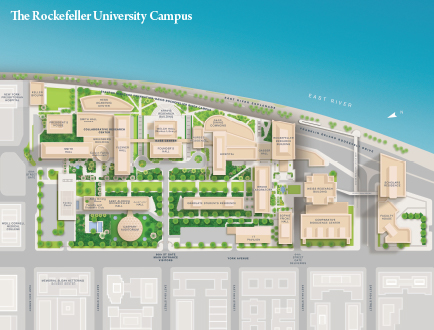Buildings
- Abby Aldrich Rockefeller Hall
- Abby Dining Room
- Bass Center
A. Welch Hall (Markus Library) - Bass Dining Commons
- Bronk Laboratory
- Caspary Auditorium
- Caspary Hall
- Collaborative Research Center
A. Carson Family Auditorium
B. Flexner Hall
C. Greenberg Building
D. Smith Hall
E. Smith Hall Annex - Comparative Bioscience Center
- Faculty and Student Club
- Faculty House
- Founder's Hall
- Fricke Hall
- Gasser Hall
- Graduate Students Residence
- Hess Academic Center
- Hospital (Heilbrunn Outpatient Research Center)
- Kellen Biolink
- Kravis Research Building
- Nurses Residence
- Peggy Rockefeller Plaza
- Philosophers Garden
- Power House
- President's House
- Rockefeller Research Building
- Scholars Residence
- Tennis Court
- Weiss Research Building
Welcome

The Rockefeller University shares the intersection of York Avenue and East 68th Street with Memorial Sloan Kettering Cancer Center and New York-Presbyterian Hospital/Weill Cornell Medicine.
The university's main entrance is at 1230 York Avenue (at East 66th Street) on Manhattan's Upper East Side.
